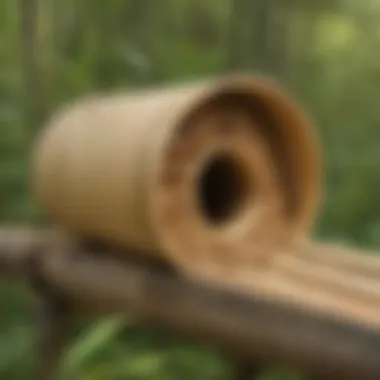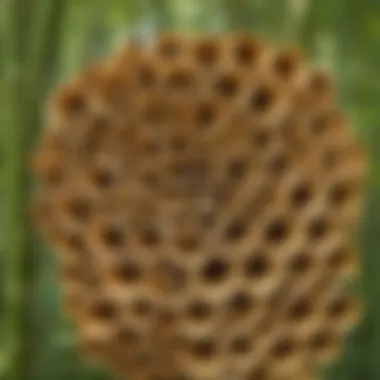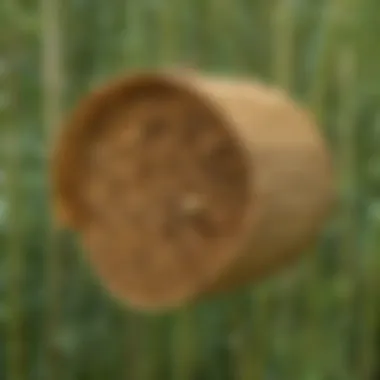Innovative Bamboo Tube Nesting for Bees: A Green Conservation Approach


Science Fun Facts
Bamboo, known for its strength and flexibility, is extensively used in various eco-friendly solutions. The stem of bamboo is hollow, making it an ideal material for creating tubes for bees to nest in. Discovery Channel highlighted a study on how bamboo tubes can benefit bees, showcasing the innovation and creativity in conservation efforts.Read on to explore the intriguing world of bamboo tubes for bees!
Discover the Wonders of Science
In this section, we will delve into the scientific aspects behind the use of bamboo tubes for bees. From understanding the nesting behavior of bees to exploring the bio-compatibility of bamboo, you will gain insights into the intersection of ecology and engineering that makes this solution sustainable and effective. Throughout this exploration, we will uncover the real-life applications of this innovative approach, showcasing how science can inspire practical solutions for environmental challenges.
Science Quiz Time
Get ready for an interactive learning experience with our science quiz on bamboo tubes for bees! Test your knowledge on the benefits of bamboo as nesting material and the impact of this solution on biodiversity. Challenge yourself with brain teasers related to bee habitat conservation and discover the fascinating world of bees in a fun and engaging way!
Science Experiment Showcase
In this hands-on section, we will guide you through a step-by-step experiment on creating bamboo tubes for bees. From gathering materials to ensuring safety precautions, you will learn how to contribute to bee conservation efforts in your own backyard. Get ready to engage in a meaningful science experiment that not only educates but also empowers you to make a difference in the world of pollinators!
Introduction
In the realm of sustainable conservation practices, the innovative use of bamboo tubes for bees stands out as a remarkable solution. This article delves into the meticulous implementation of bamboo tubes as nesting materials for bees, emphasizing its role in supporting bee populations and fostering biodiversity. By exploring the unique characteristics of bamboo and its environmental benefits, we uncover a creative and eco-friendly approach that holds great promise for bee conservation.


Understanding the Importance of Bees
Bees play a pivotal role in our ecosystem, serving as pollinators essential for the reproduction of flowering plants. Their importance cannot be overstated, as a significant portion of the world's food supply relies on bee-mediated pollination. Furthermore, bees contribute to the overall health of ecosystems by promoting plant diversity and ensuring the sustainability of natural habitats.
Challenges Faced by Bee Populations
Despite their critical role, bee populations worldwide face numerous challenges that jeopardize their existence. Factors such as habitat loss, pesticide exposure, climate change, and diseases have led to a decline in bee numbers. This decline not only threatens agricultural productivity but also puts ecosystems at risk, highlighting the urgent need for conservation efforts to safeguard bee populations.
The Role of Nesting Materials in Bee Conservation
Nesting materials form an integral part of bee conservation strategies, providing bees with suitable shelters for reproduction and nurturing their young. The choice of nesting material can significantly impact bee health and survival. By examining the importance of nesting materials in bee conservation, we gain insight into how innovative solutions like bamboo tubes can offer sustainable alternatives that cater to the needs of these essential pollinators.
Exploring Bamboo as a Sustainable Alternative
In this section, we will delve into the critical importance of exploring bamboo as a sustainable alternative in the realm of bee conservation. Bamboo, often hailed for its versatility and eco-friendly attributes, emerges as a beacon of hope for bee populations facing mounting challenges in their natural habitats. Within the context of this article, focusing on the specific elements and nuances surrounding bamboo's utility for nesting materials will shed light on its potential to revolutionize bee conservation efforts.
Characteristics of Bamboo for Nesting
Bamboo stands out as an exceptional choice for nesting materials due to its innate durability and abundance. The hollow structure of bamboo stems provides an ideal environment for bees to establish their nests, offering insulation and protection vital for the well-being of bee communities. Its resistance to harsh weather conditions further solidifies its suitability for creating sustainable habitats for bees, ensuring their safety and longevity.


Environmental Benefits of Bamboo
Not only does bamboo serve as a practical nesting material, but it also boasts remarkable environmental benefits. As one of the fastest-growing plants on the planet, bamboo replenishes itself rapidly, making it a highly renewable resource. Its cultivation does not require pesticides or fertilizers, promoting a more sustainable and eco-conscious approach to supporting bee populations. Additionally, bamboo forests contribute significantly to carbon sequestration, playing a crucial role in mitigating climate change.
Comparing Bamboo Tubes with Traditional Nesting Materials
When comparing bamboo tubes with traditional nesting materials such as wood or plastic, bamboo emerges as a clear frontrunner in terms of sustainability and functionality. Unlike wood, which may involve deforestation and longer regrowth periods, bamboo cultivation does not contribute to habitat destruction, making it a more environmentally friendly choice. Moreover, bamboo tubes offer superior insulation and weather resistance compared to plastic alternatives, ensuring a more conducive habitat for bees to thrive and propagate.
Design and Implementation of Bamboo Tubes
The Design and Implementation of Bamboo Tubes section in this article extensively explores the innovative approach of utilizing bamboo tubes as nesting materials for bees. This sustainable solution plays a crucial role in supporting bee populations and promoting biodiversity. Bamboo's unique characteristics make it an ideal material for bee nests due to its durability, natural abundance, and eco-friendly properties. By delving into the intricacies of designing and implementing bamboo tubes, this section sheds light on how this method can revolutionize bee conservation efforts. The benefits of bamboo, such as being biodegradable and sustainable, are highlighted, emphasizing its significance in sustainable beekeeping practices.
Creating Bamboo Tube Structures
Creating Bamboo Tube Structures is a fundamental aspect of incorporating bamboo tubes into bee conservation initiatives. This process involves carefully crafting and assembling bamboo tubes to provide safe and conducive nesting environments for bees. Ensuring the appropriate diameter and length of the tubes is essential to accommodate different bee species effectively. Additionally, the construction of bamboo tube structures requires precision to prevent any damage or disruptions to bee habitats. By detailing the step-by-step process of creating these structures, bee enthusiasts and conservationists can gain valuable insights into enhancing bee populations through sustainable means.
Placement and Maintenance Considerations
Effective Placement and Maintenance Considerations are crucial for the success of bamboo tube bee shelters. Strategic placement of these structures in areas with sufficient floral resources and minimal human interference is key to attract bees and support their nesting activities. Regular inspection and maintenance of bamboo tubes are necessary to ensure their durability and functionality in providing safe habitats for bees. By elaborating on the importance of proper placement and maintenance practices, this section equips readers with essential knowledge to maximize the effectiveness of bamboo tubes in enhancing bee populations and preserving biodiversity.


Monitoring Bee Activity in Bamboo Tubes
Monitoring Bee Activity in Bamboo Tubes offers valuable insights into the behavioral patterns and success rates of bee colonies housed in bamboo structures. By closely observing the activity levels, diversity of species, and reproductive success within the bamboo tubes, conservationists can evaluate the impact of this sustainable solution on bee populations. Implementing monitoring techniques, such as regular observations and data recording, allows researchers and bee enthusiasts to track the effectiveness of bamboo tubes in promoting bee health and biodiversity. By emphasizing the significance of monitoring bee activity, this section underscores the importance of continuous assessment and adjustment in sustainable bee conservation practices.
Impact on Bee Populations and Biodiversity
In the realm of bee conservation, focusing on the impact on bee populations and biodiversity is crucial. Understanding how innovative solutions, such as using bamboo tubes, can positively influence these aspects is essential. These bamboo tubes not only provide nesting spaces for bees but also contribute significantly to enhancing biodiversity through promoting diverse bee habitats. By adopting sustainable practices like utilizing bamboo tubes, we take a step forward in safeguarding bee populations that play a vital role in maintaining the delicate balance of ecosystems.
Enhancing Bee Habitat Diversity
Enhancing bee habitat diversity is a key aspect of bee conservation. By integrating bamboo tubes into bee habitats, we offer bees a range of nesting options, enriching their living environments. This diversity in nesting materials can attract a wider variety of bees, contributing to the overall richness of bee species in an area. Bamboo tubes, with their unique properties and environmental benefits, provide a valuable and sustainable solution to bolstering bee habitat diversity and ensuring the well-being of bee populations.
Promoting Pollination through Bamboo Tube Adoption
The adoption of bamboo tubes for bee nesting not only supports bee populations but also plays a vital role in promoting pollination. Bees, as primary pollinators, are crucial for the reproduction of many plants, including agricultural crops. By encouraging bee populations through the provision of bamboo tube shelters, we indirectly enhance the pollination process. Increased pollination rates lead to greater crop yields, thus underlining the significance of using innovative methods like bamboo tubes to support bees and foster a healthier ecosystem.
Contributing to Conservation Efforts
Integrating bamboo tubes into bee conservation efforts represents a significant contribution to the overarching goal of preserving biodiversity. By embracing sustainable practices like using bamboo tubes, conservation initiatives become more effective and environmentally friendly. Supporting bee populations through such initiatives not only aids in conserving bees but also has a ripple effect on other species and the overall ecosystem. Therefore, by actively engaging in bamboo tube adoption for bee conservation, we take a proactive step towards long-term conservation and sustainability.
Conclusion
Embracing Bamboo Tubes for Sustainable Bee Conservation
Embracing bamboo tubes for sustainable bee conservation is crucial in preserving bee populations and promoting biodiversity. Bamboo, known for its sustainability and versatility, offers bees an excellent nesting material that supports their well-being and reproduction. By opting for bamboo tubes over synthetic or non-biodegradable materials, we are reducing the environmental footprint of bee conservation efforts and contributing to a greener ecosystem. Placing and maintaining bamboo tubes strategically play a vital role in maximizing their utility for bees and ensuring long-term benefits for bee populations. Monitoring bee activity in bamboo tubes allows for valuable insights into bee behavior and the effectiveness of these sustainable nesting structures. By actively promoting the adoption of bamboo tubes for bee conservation, we not only address the challenges faced by bee populations but also set a positive example for sustainable practices in wildlife conservation. Embracing bamboo tubes signifies a shift towards environmentally conscious beekeeping practices and demonstrates our commitment to preserving biodiversity by providing bees with a safe and natural habitat.







